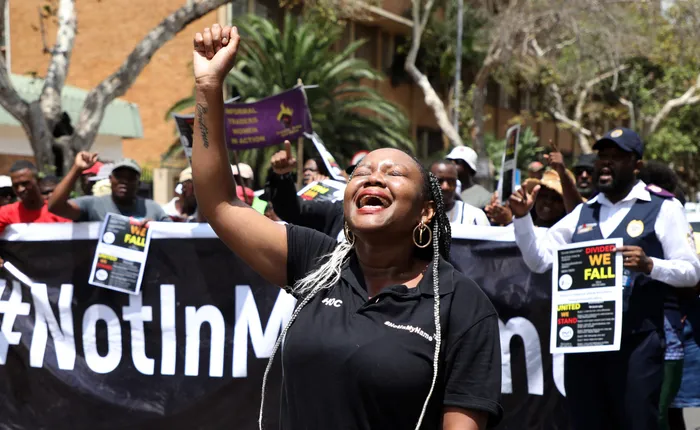Load shedding violates rights of vulnerable communities

Picture: Oupa Mokoena/African News Agency (ANA) – #NotInMyName march to Nersa and Union Buildings on January 20, 2023, in Pretoria, against loadshedding and high electricity costs.
By Kershni Ramreddi
Loadshedding is a reality that we must all deal with for the foreseeable future. Unfortunately, the frequent daily power outages have had an impact on numerous industries across the nation.
The most vulnerable members of the community are impacted by load shedding, including schoolchildren, those working in the agriculture and tourism industries, public hospitals, small businesses, and other essential sectors.
Small businesses frequently miss deadlines, put up with unfavourable circumstances, and experience consumer dissatisfaction. Loadshedding has a significant impact on hospitals and healthcare professionals as well. Sadly, when load shedding occurs, many public hospitals are unable to deliver quality medical care.
Although many people do have generators for backup electricity, this is not a sustainable alternative. Due to the unavailability of alternate electrical sources in many schools, loadshedding interferes with teaching and learning. South Africans will likely have to put up with stages two and three load shedding for the next two years to allow the state-owned utility to perform maintenance on its power generating facilities, Eskom chairperson Mpho Makwana said.
Residents have recently been subjected to stage six rolling blackouts, which means that certain districts are without power for up to 10 hours every day. Load shedding has a negative influence on our capacity to earn a living, seek trustworthy healthcare, have faith in the cold chain that transports the majority of our food, and trust the purity of the water in our taps.
According to the City of Tshwane and uMgungundlovu District Municipality in the KwaZulu-Natal Midlands, its reservoirs depend on a constant flow to maintain levels and be ready for outages. The pump stations’ ability to operate and carry water continuously depends on Eskom’s grid for power and the pump stations’ ability to operate.
Millions of litres of untreated sewage spilt into rivers, harbours, the ocean and washed up on beaches in and around Durban because of the floods in KwaZulu-Natal in April last year, which also damaged eight sewerage treatment plants. The infrastructure has just been partially restored, and the waters around Durban are still contaminated. The country is getting closer to having widespread water insecurity as a result of the severe stress placed on South Africa’s freshwater resources. If action is not taken; social, environmental, and economic realms will be threatened.
These water problems have numerous causes, including both natural and man-made ones. They include the continued decline in the provision of services specifically related to water access, dependable water supply, and sanitation services. They also include the unacceptably high physical water losses, unsustainable water demands and withdrawals by various water users, ongoing and worsening water pollution, increased flooding, and prolonged droughts brought on by increased climate variability. The management of water resources must be done wisely and optimally, which is not being done by the government on a national and local level.
A “business as usual” strategy is not an option because it will have adverse effects. Due to the failure of their reservoirs to refill, power disruptions will have a negative impact on the availability of water. Sewage overflows will be made worse by the absence of backup pumps in sewage treatment facilities. Water supply will be reduced because of rising water pollution, and there may even be a lack of water because the water will no longer be suitable for consumption.
Unless significant efforts are made to address fundamental restrictions like the absence of sufficient human resources, which include individuals with appropriate qualifications as well as skills and experience, poor or a complete lack of service delivery in both rural and urban contexts will continue to be a problem.
The need to maximise water supply, efficiency, and conservation while minimising water demand and continuing significant water losses must be the main areas of focus. Among the options for action include increasing productivity, using new technology, cutting down on water waste, raising awareness of the importance of water conservation, enforcing current laws and regulations, recovering costs, and offering incentives.
To solve the backlog of delivering water and sanitation services, especially in rural regions, it is necessary to expand water services to areas that do not already have them and to improve service standards. To address the nation’s significant water pollution issues and maintain reliable water supply and wastewater treatment compliance, it is predicted that R90 billion in annual investment would be needed in the water and sanitation infrastructure sector over the next 10 years.
To establish accountability, it is necessary to look into municipal incompetence, neglect of ageing infrastructure, and institutional issues with alleged corruption and poor management. The vicious cycle of insufficient water and sanitation services will be caused or made worse by a persistent relationship between poor infrastructure, poor management, and low revenue sources. To address acute issues in the short term and seek to secure water security in the medium and long term, systematic and well-studied informed actions and interventions, as well as true political will, are required.
Ramreddi is an Energy and Just Transition Project Officer at South Durban Community Environmental Alliance.